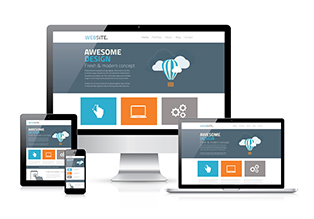
Modern-day consumers are more tech-savvy than ever before. They expect to find information on your company or product online with just one click of the mouse. If they can’t easily find what they’re looking for, you’ve lost their interest and trust in your brand. A website that doesn’t offer a quality user experience will frustrate potential customers and discourage them from coming back again. Your business needs an online presence that is dynamic, informative, and interactive in order to stay competitive today!
So, what is it about website design that can make or break your business? We’ve put together the top three traits of every effective website to help you find out.
1) Attractive design without sacrificing user-friendliness
A site’s online appearance has a huge impact on how consumers perceive your business and whether they trust you enough to complete a purchase. It’s not just about how visually pleasing your website is, though! The design should be clear and concise, making it easy for visitors to find the content they’re looking for quickly and efficiently. An engaging site will inspire consumers’ confidence in you and create a positive first impression.
At the same time, however, you don’t want to distract visitors with too many options and links. Your site should be simple and easy for users to navigate, and the best way to do that is by offering plenty of useful information without sacrificing familiarity. When in doubt, it’s always better to err on the simpler side when designing your web page!
2) A streamlined user experience

As an online business, you have to think about your site’s ease of use every step of the way. You should also consider how easily shoppers can use their chosen web browser, as well as whether they’re using a desktop computer or mobile device.
For example, if customers search for information on your site and find nothing but advertisements, their experience will be disappointing. Websites should always provide content that is helpful and relevant to the search terms or keywords that drive traffic to your site in the first place. If you fail to achieve that, then you’ll end up wasting valuable time and money on online advertising!
Also, when it comes to ecommerce websites, you need to make sure that it is as easy as possible for customers to complete their orders. Sometimes this means placing an order button above the fold with a clearly delineated shopping cart at or near the top of your site. You should also consider offering multiple shipping options with quick shipping times in addition to any free shipping promotions you can offer.
3) A clear call to action
It’s important for an effective site to have clearly defined goals. This means that you should always provide visitors with a reason why they should stay on your site and peruse your content, whether that be reading news updates or viewing product pages. If you fail to give them that push in the right direction, then they have no incentive to stick around!
You should always be brainstorming new ways in which you can engage your target audience with the content that you publish on your site. If you can find creative ways to interact with your visitors, then they’ll keep coming back again and again for more information. This two-way dialogue will ultimately strengthen your relationship with them and increase your potential for turning casual website visitors into actual customers in the future.
Why Choose a Dynamic Website for Your Business?
Most consumers are skeptical of any business that doesn’t have an online component today. If you’re not making your presence known on the web, then you’re missing out on countless opportunities to attract new customers and increase revenue.

Of course, there’s no end to the benefits that a dynamic website can offer for your business! It doesn’t matter if you’re selling physical or digital products, as long as your website can effectively communicate your brand’s unique message and contribute to its overall identity.
1. Ease of Editing
The advantage of using a dynamic website platform or template is that you can edit it after your site goes live without having to perform any coding. This flexibility allows you to start small and build up over time.
For example, you can easily update the site’s colors, layout, text and images with just a few clicks of your mouse! These changes are often reflected instantaneously, which is great for your users who want to see immediate results. Also, dynamic websites are designed to be SEO-friendly with meta tags that describe different elements of your content more clearly to search engines.
2. Intuitive Interface

Many modern website templates are also designed with the user in mind. For instance, sites that use a content management system (CMS) allow you to complete tasks without any prior technical knowledge or experience. This is especially critical if you’re looking for a unique website design within your budget.
Also, Internet users generally want to find solutions and answers quickly without the need for extensive troubleshooting at every turn. Dynamic websites are built with this in mind by providing an intuitive interface that allows visitors to easily navigate from page to page and complete transactions efficiently even if they’re using a mobile device such as a laptop or tablet!
3. Flexibility and Scalability
Dynamic websites are also scalable, which means that you can edit them for different devices and screen sizes. This is great whether you’re selling products online, providing an ecommerce platform or sharing your company’s latest news!
Since today’s target audiences are using their smartphones and tablets more than their desktops, it’s important to make sure that your website provides users with a great experience no matter what resolution they’re using.
4. Engage and Retain Customers
The majority of today’s websites are highly customizable as well, so you can encourage your visitors to interact with the content that you publish on your site. For instance, you could add a “share” or “like” button to each news article or Facebook post for users who want to voice their opinions about the topics that you’re writing about.
This deep level of interaction allows you to build more valuable relationships with your users since you can nurture their feedback and turn them into loyal customers over time!
5. Automation of Tasks

Finally, dynamic websites are designed to automate many tasks that would otherwise take up your valuable time. For instance, you’ll often see them employ built-in ecommerce features that help you quickly generate sales reports and inventory levels.
Dynamic sites also have automated functions for sending user notifications, collecting data on the demographics of visitors who visit each page and even creating newsletters to engage your users.
In other words, you can get the most out of dynamic websites by easily conducting business from a single location!
When building a dynamic site, it is crucial that you choose the right web development company in UK for the job. This is because there are so many free sites out there with underdeveloped content. With so many options, it’s easy for a business to make the wrong choice and end up with a site that fails to communicate its brand.